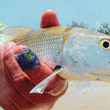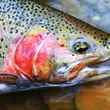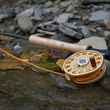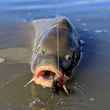It's that time of year: The time when that most glamorous of gamefish, Salmo salar, "the leaper," returns from the ocean and ascends its natal streams to spawn—there to be pursued by legions of impassioned anglers, anglers who essay hundreds, even thousands of casts hoping to feel the urgent throb of an Atlantic salmon on the end of their line.
Atlantic salmon don’t feed in fresh water, of course; as Lee Wulff so famously put it, what you fish for, really, is their memory of feeding. And of the countless flies devised in the hopes of triggering that memory, the most iconic are the full-dress featherwing patterns, a class exemplified by the likes of the Jock Scott (certainly the most famous salmon pattern of all), the Durham Ranger, and the Thunder-and-Lightning. Stunningly ornate, bafflingly complex, and obscenely challenging to tie, these flights of fancy proliferated in the Victorian and Edwardian eras, when the sun never set on the British Empire and “fly-dressers,” as they were called then, had access to literally every feather their hearts desired.
These days, few featherwing flies ever feel the cool caress of salmon water, their place having been almost wholly taken over by less expensive (and more durable) hairwing patterns. They’re still being tied for decorative and artistic purposes, however, and tyers of skill and imagination are still taking the basic featherwing template and designing new patterns in the classic style.
Pete Fleischman of Neenah, Wisconsin, is one such tyer. I need to come clean here and acknowledge that Pete is a friend and fishing buddy—the kind of friend and fishing buddy who will not only show you his favorite stretch of Hex water but take you to his secret brook trout pond without blindfolding you first. Pete also happens to be a fabulous fly-tyer, a meticulous craftsman whose trout flies are exquisite but who especially relishes the intricate challenge posed by classic featherwing salmon flies. I mean, the guy forges and snells his own hooks, for crying out loud!
Recently, in honor of his daughter Katie’s earning her doctorate in pediatric psychology from the University of Wisconsin-Milwaukee, Pete designed a fly he calls the Ph.D. Elegant, balanced, and based on the UW-M school colors—black, gold, and magenta—its materials include feathers from golden pheasant, wood duck, speckled bustard, turkey, and jungle cock. There’s also Japanese silk, black ostrich herl, oval silver tinsel—the list goes on.
Pete once told me that if his house burned down, the only thing he’d really miss would be his fly-tying materials. “I have more than a lot of fly shops do,” he laughed.
Now, any father would be proud of his daughter for earning a doctorate, but in this instance there’s a movie-worthy back story: In 1994, when Katie was 13, a nagging pain in her leg proved to be advanced osteosarcoma—bone cancer, in layman’s terms. During a 15-hour limb-salvage procedure at Children’s Hospital in Milwaukee (it shouldn’t have taken that long, but there were unforeseen complications), Katie received a prosthetic knee and bone implants that allowed her to keep her leg and a large degree of normal function. A year of intensive chemotherapy followed and as soon as Katie got the all-clear from her doctors she and her parents jetted off for her Make-A-Wish adventure: diving in the Cayman Islands.
Cancer may have gotten in her way, but damned if she was going to let it slow her down.
Katie’s struggles weren’t completely behind her, though. As a teenager she wrestled with debilitating emotional issues, and when she emerged from that dark place, stronger for the experience, she felt a passionate calling to help children in extremis. And she has devoted herself to this cause ever since. Now a nationally recognized authority on pediatric pain management, she’s a Staff Psychologist at Boston Children’s Hospital and an Instructor of Psychology at Harvard Medical School.
Yeah, “Wow” is right. I kid Pete that Katie can’t possibly be his daughter and he laughs that the only thing she got from him is his stubbornness.
And now she’s inspired an Atlantic salmon fly. She probably won’t include this tidbit on her CV, but still, how many of us can say that?
































Comments